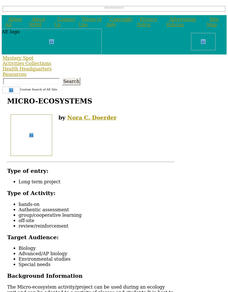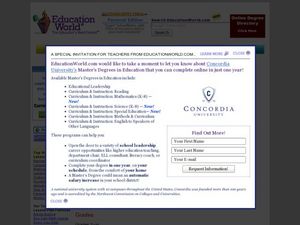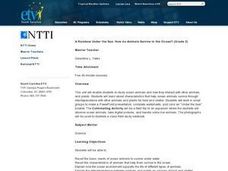Curated OER
Water Properties of the Great Salt Lake
Fourth graders examine the ecosystem of the Great Salt Lake in this two-part lesson, completing a KWL chart before and after the field trip to the site. While there, they draw and write about their observations. To test for buoyancy,...
Sargent Art
Protect Our Marine Life
Encourage water conservation and boost art skills with a hands-on activity that challenges young painters to create a scene highlighting marine life. Using oil pastels, scholars draw an underwater scene and write a tip for viewers to...
Curated OER
Water Wonders
Students explore hydrology concepts. In this environment and biology instructional activity, students identify and describe macroinvertebrates using a variety of pictures and resources. Students observe and write about a classroom...
Curated OER
Raising Trout
Learners investigate the life cycles of fish as they observe a trout's life in class. For this fish life lesson, students create a proper habitat in a fish tank for the trout eggs to spawn and thrive for several weeks. Learners record...
Curated OER
Micro-Ecosystems
Students create a sustainable, self-contained ecosystem in a ten-gallon aquarium.
Curated OER
Pond Ecology
Fifth graders examine pond ecology, testing how temperature affects the respiration rate of fish. They collect various living things found at a pond, and identify the animal and plant life discovered. They observe a pond community in an...
Curated OER
Understanding Estuaries
Students work together to develop their own estuarine ecosystem in an aquarium. They observe the aquarium daily and record them in a notebook. They discuss the different interactions they see with the class.
Curated OER
Zoobilation
Students research and use their findings to design a PowerPoint presentation and zoo-type habitat with the correct ecosystem for their animal group using a variety of materials such as cardboard boxes, aquariums etc.
Sea World
Ocean Discovery
Immerse your young marine biologists in the world of marine animals. The lesson includes several activities that are age-appropriate for preschoolers and kindergartners, including coloring pages, gluing feathers and sand onto paper...
Curated OER
Sea Horse Habitats
Students research sea horses around the world. In this sea horse habitats lesson plan, students use the Internet to take a virtual tour of a sea horse in its natural habitat. Students work in groups to study a geographical region such...
Curated OER
Baby Animals Debut at Zoos
Students determine the names of animal babies, then read a news article about zoo's experiencing animal births. In this current events lesson, the teacher introduces the article with vocabulary activities, then students read the news...
Curated OER
What is a Shark?
Students discuss their knowledge of sharks. In this shark lesson, students read about various sharks and look up shark sightings in an online newspaper. They create Shark-shaped poetry.
Curated OER
Top Budget-Friendly Ways to Include Interactive Technology in the Classroom
Inspire student achievement and participation with multimedia activities.
Curated OER
We're All In This Together
Students discover what a coral reef is and the animals that live there. In this ecosystem lesson plan, students act out a story with ocean organisms. They answer questions that show the interdependency of the sea animals.
Curated OER
Zoom to the Future: Using Future Tense Verbs
In this future tense verbs learning exercise, students underline the verbs and the helping verbs in 9 sentences. Students check over their answers when done with the learning exercise.
Curated OER
The Intertidal Zone
Young scholars research the diverse animal and plant life that inhabit the intertidal zones along the Pacific rocky coast. As students progress through this lesson, they begin to recognize distinct behaviors, adaptations, and...
Curated OER
Utilizing Community Resources
Students gain an understanding of scientific methods and use process skills (such as observing, classifying, and predicting) to solve a problem. They develop an understanding of the need for natural preservation.
Curated OER
Observing and Recording Biological Data
Learners create their own definition of life. They identify the eight characteristics of life in organisms. They compare and contrast the characteristics of living and nonliving things.
Curated OER
A Rainbow Under the Sea: How do Animals Survive in the Ocean?
Second graders read books, watch videos, complete worksheets and participate in class discussions about ocean animals. They, in groups, design PowerPoint presentations on selected marine animals.
Curated OER
Hide and Seek Science
Pupils examine macro-invertebrates in order to better understand their link to the food web. Working in groups, they record observations of several areas of a stream or river, collect samples from the river bottom, and identify the...
Curated OER
Trout In The Classroom
Pupils have trout in their classroom and complete journaling, checklists, temperature checking, and ammonia level recording. In this trout lesson plan, take weekly observation records of their trout.
Curated OER
Bye-Bye Trout Song
Students develop an understanding about what will happen to trout after they are released into the trout stream. In this trout life lesson, students discuss how it feels to release the trout they have cared for. Students also sing a song...
Curated OER
A Rainbow Under the Sea: How Do Animals Survive in the Ocean?
Second graders, with adult help, create a PowerPoint presentation on a selected ocean animal.
Curated OER
Learning About Animals' Bodies
Students research different animals (mammals, reptiles, amphibians, insects, birds, fish) and create books, murals, dioramas, puppets, and sculptures to illustrate the necessity of various body parts for overall survival. In this animal...
Other popular searches
- Shedd Aquarium Field Trip
- Aquarium Field Trip Dallas
- Aquarium Field Trip Bingo
- She Dd Aquarium Field Trip

























